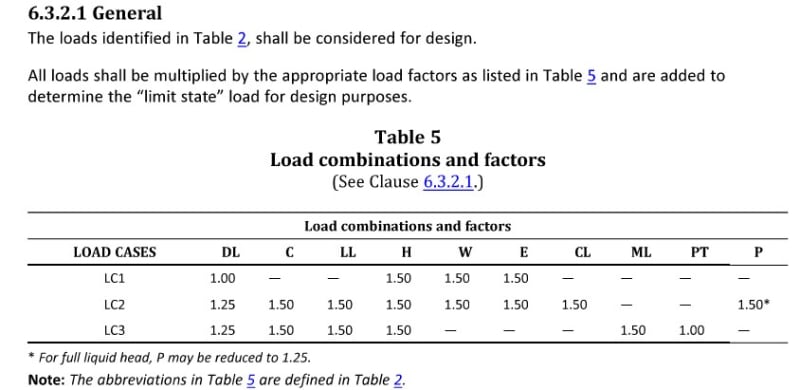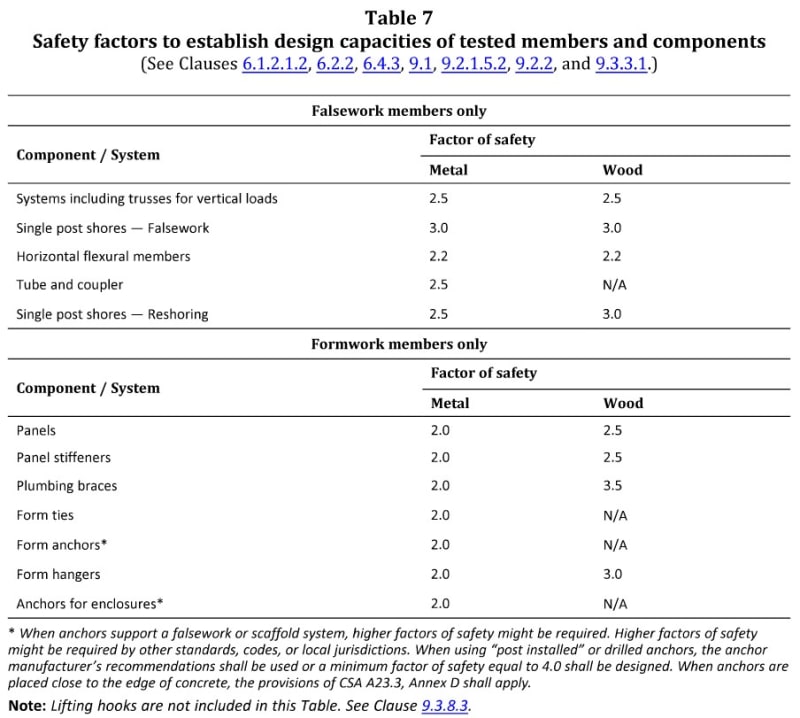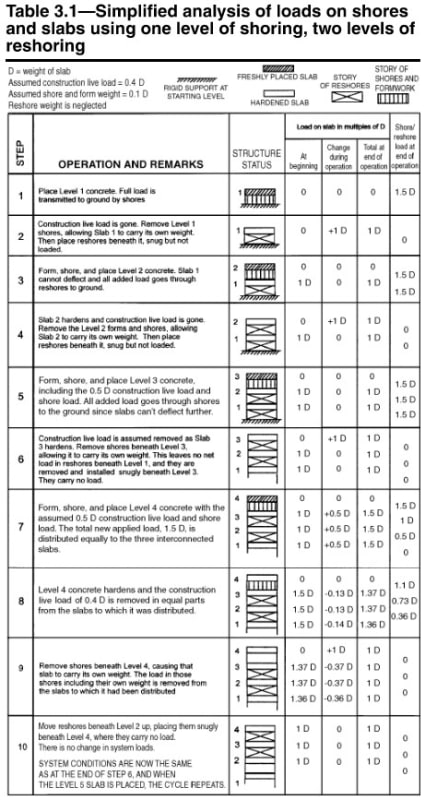Struct123ure
Structural
- May 16, 2023
- 40
Hi,
I am trying to clear up what safety factors or load combinations we should be using when designing formwork and reshoring. I am using CSA S269.1 (Canada) but have also reviewed ACI 347-04 Table 2.3 which lays out the safety factors. These factors vary based on the component one is analyzing which is where my confusion lies.
Please see attached sketch where I numbered the components. The Concrete pour is designed for Pmax=Cw*Cc*[Calculation CSA or ACI].
1. In case of Wood formwork the plywood is designed for ULS combination from Table 5 and serviceability is checked for SLS.

2. For vertical studs same as the plywood.
3. For steel W section walers same as plywood (ultimate plastic capacity compared to ULS and deflection checked for SLS).
4. If we are using a ‘A frame’ to support a one sided pour from a manufacturer, I compare their design sheets to my SLS load. The manufacturers I have reached out to said they have a FS=3 which I can then compare ULS to their (design sheets capacity)*3. I don’t need to factor up my SLS load, because I am not sure what I would be comparing it to?
5. Connections:
Nails, Structural Screws, Structural Steel Bolts designed for ULS load, no additional safety factor.
If using a manufactures A Frame they usually have a connection system that is pre-designed to connect to their A Frame. This I can compare to SLS load because like the A Frame it would have a safety factor (I would confirm this in writing if not obvious from documentation).
6. When reshoring a slab(when on SOG), I am comparing the SLS load combination (DL+LL) with the capacity provided by the jack manufacturer?
I then compare the ULS (Table 5) loading with the reshoring jack max capacity? Most manufacturers have a 2x or 3x safety factor.
If theoretically I am designing wood shoring (built form sawn lumber), I design it for ULS load and check SLS deflection. I am getting mixed up because the CSA has Table 7 which has a safety factor of 3 for “singe post shores”, but to my understanding that is for allowable stress design not LRFD.

7. Hilti or Dewalt or etc. mechanical/epoxy anchors I would compare the ULS load to their design capacity (same as items 5 above). Even though Hilti has a built-in safety factor of 4. To me it seems a little overkill especially when considering that weight of concrete factor is 1.5 for ULS already?
8. In terms of overall reshoring such as for high rise (shores off SOG) I see people reference the ACI 347.2R simplified method. I have transfer slabs at floor 5, floor 9 so I don’t fall under the “Construction Live Load=0.4D and Form Weight=0.1D”. I was thinking of adjusting the D factor, but I think I am overcomplicating things.
Simply I take the SLS load of the concrete pour and divide by the SDL+LL capacity of the slabs below to see how many slabs I need to engage(Slab capacities are to be adjusted if concrete hasn’t reached design strength). Then I take the ULS load of the concrete pour and divide by the 1.25*SDL+1.5*LL (1.2*SDL+1.6*LL – ACI 318) capacity of the slabs below to see how many slabs I need to engage. Take the greatest and round up, that’s basically it. Careful with the slab stiffness not to overload a stiffer slab.

I am trying to clear up what safety factors or load combinations we should be using when designing formwork and reshoring. I am using CSA S269.1 (Canada) but have also reviewed ACI 347-04 Table 2.3 which lays out the safety factors. These factors vary based on the component one is analyzing which is where my confusion lies.
Please see attached sketch where I numbered the components. The Concrete pour is designed for Pmax=Cw*Cc*[Calculation CSA or ACI].
1. In case of Wood formwork the plywood is designed for ULS combination from Table 5 and serviceability is checked for SLS.

2. For vertical studs same as the plywood.
3. For steel W section walers same as plywood (ultimate plastic capacity compared to ULS and deflection checked for SLS).
4. If we are using a ‘A frame’ to support a one sided pour from a manufacturer, I compare their design sheets to my SLS load. The manufacturers I have reached out to said they have a FS=3 which I can then compare ULS to their (design sheets capacity)*3. I don’t need to factor up my SLS load, because I am not sure what I would be comparing it to?
5. Connections:
Nails, Structural Screws, Structural Steel Bolts designed for ULS load, no additional safety factor.
If using a manufactures A Frame they usually have a connection system that is pre-designed to connect to their A Frame. This I can compare to SLS load because like the A Frame it would have a safety factor (I would confirm this in writing if not obvious from documentation).
6. When reshoring a slab(when on SOG), I am comparing the SLS load combination (DL+LL) with the capacity provided by the jack manufacturer?
I then compare the ULS (Table 5) loading with the reshoring jack max capacity? Most manufacturers have a 2x or 3x safety factor.
If theoretically I am designing wood shoring (built form sawn lumber), I design it for ULS load and check SLS deflection. I am getting mixed up because the CSA has Table 7 which has a safety factor of 3 for “singe post shores”, but to my understanding that is for allowable stress design not LRFD.

7. Hilti or Dewalt or etc. mechanical/epoxy anchors I would compare the ULS load to their design capacity (same as items 5 above). Even though Hilti has a built-in safety factor of 4. To me it seems a little overkill especially when considering that weight of concrete factor is 1.5 for ULS already?
8. In terms of overall reshoring such as for high rise (shores off SOG) I see people reference the ACI 347.2R simplified method. I have transfer slabs at floor 5, floor 9 so I don’t fall under the “Construction Live Load=0.4D and Form Weight=0.1D”. I was thinking of adjusting the D factor, but I think I am overcomplicating things.
Simply I take the SLS load of the concrete pour and divide by the SDL+LL capacity of the slabs below to see how many slabs I need to engage(Slab capacities are to be adjusted if concrete hasn’t reached design strength). Then I take the ULS load of the concrete pour and divide by the 1.25*SDL+1.5*LL (1.2*SDL+1.6*LL – ACI 318) capacity of the slabs below to see how many slabs I need to engage. Take the greatest and round up, that’s basically it. Careful with the slab stiffness not to overload a stiffer slab.

